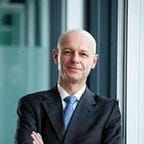Minds + Machines Day 2 — It’s practical
by Marco Annunziata
The second day of our Minds and Machines conference focused on the practical aspects of the industrial internet. Jeff said in his opening speech on day 1 that “industrial internet” is a fancy term, but what it really means is more efficiency, no unplanned downtime, more productivity. Practical results, achieved through practical steps.
So our Day 2 sessions focused on very practical aspects: how does the Predix platform work, how do you go from the data to understanding how to improve the performance of a gas turbine or an MRI machine, and how do you ensure that the technicians and managers can make sense of the data in a quick and intuitive way.
We also discussed the connection between industrial internet and advanced manufacturing. In other words, data and software are nor just useful to improve the efficiency of a machine that you have already built. You can use them to improve your production process in the first place: use data and software simulations to improve efficiency on the factory floor, accelerate the cycle of design-prototyping-production, and adjust more quickly to shocks to the supply chain or demand conditions.
Two issues from Day 2 are worth highlighting.
The first is cyber security. As industrial machines and operations become software-defined and interconnected, we are opening new areas of vulnerability. If it is software-based, it can be hacked. Staying ahead of the game is tremendously important. We have to be smart about it. Realize that this will be a long-run game: cyber security will be a constant effort, not something you can achieve and lock in. But also realize that it can be done. Cyber risks have been around since computers first came onto the scene. They have not stopped the consumer internet, and they will not stop the industrial internet. But we have to take it seriously. Very important, and very practical.
The second is connected cities. This starts from the revolution of intelligent lighting, which I discussed in an earlier post. It might sound less “industrial” than a jet engine or a wind turbine, but this is where the benefits of the industrial internet will be most clear and tangible for all of us. Cities where sensors-equipped lighting systems improve traffic flow and parking, reduce pollution and energy consumption, and improve safety. A future where a single app might allow you to control heat and lighting in your home, book a parking spot near the restaurant, manage all your interactions with the city services. A better quality of life. We have a pilot project with the city of San Diego that is starting to turn a lot of these ideas into reality. Again, very practical.
The day was book-ended by two visionary sessions. Mickey McManus, currently a research fellow at Autodesk, gave us a tour of some of the newest technologies, including 4D printing — 3D printed objects with embedded software that guides them to change through time. Andy McAfee, principal research scientist at MIT, focused on the complementarity of minds and machines.
The second half of the chessboard
Both Mickey and Andy stressed that these innovations are accelerating now, because they build on stronger accumulated basis of technological advances. Andy used Ray Kurzweil’s “second half of the chessboard” metaphor. The lore is that the inventor of chess asked to be rewarded with a grain of rice for the first square of the board, two for the second, four for the third, eight for the fourth, and so on, doubling the number of grains at every square. Once you do the math you realize that for the first thirty-two squares, the quantity of rice gets very large but manageable. As you move to the second half of the chessboard, you are doubling starting from a very large basis. So the second half of the chessboard accrues an amount of rice that is over 2 billion times more than the first (and the whole chessboard is worth an Everest of rice…). If we are entering the second half of the chessboard, we really ain’t seen nothing yet…
I will be back tomorrow for the Day 3 and conference wrap. Meanwhile, if you missed it, here are the Day 1 opening speeches, well worth watching.
Marco Annunziata is GE’s Chief Economist
